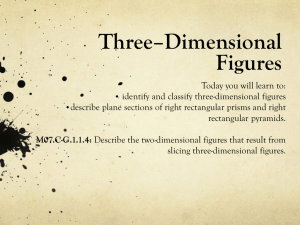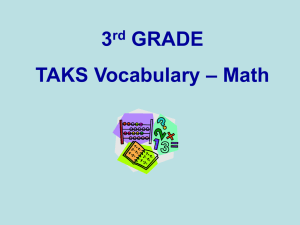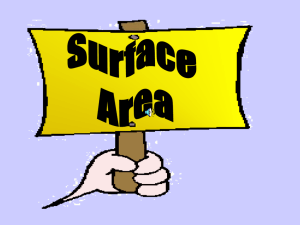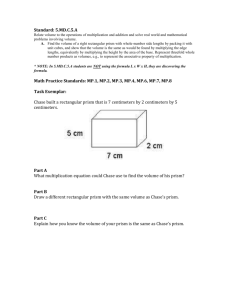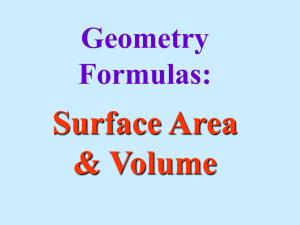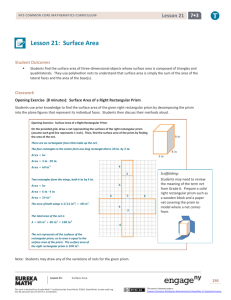Unit 5--Overview and Terms
advertisement
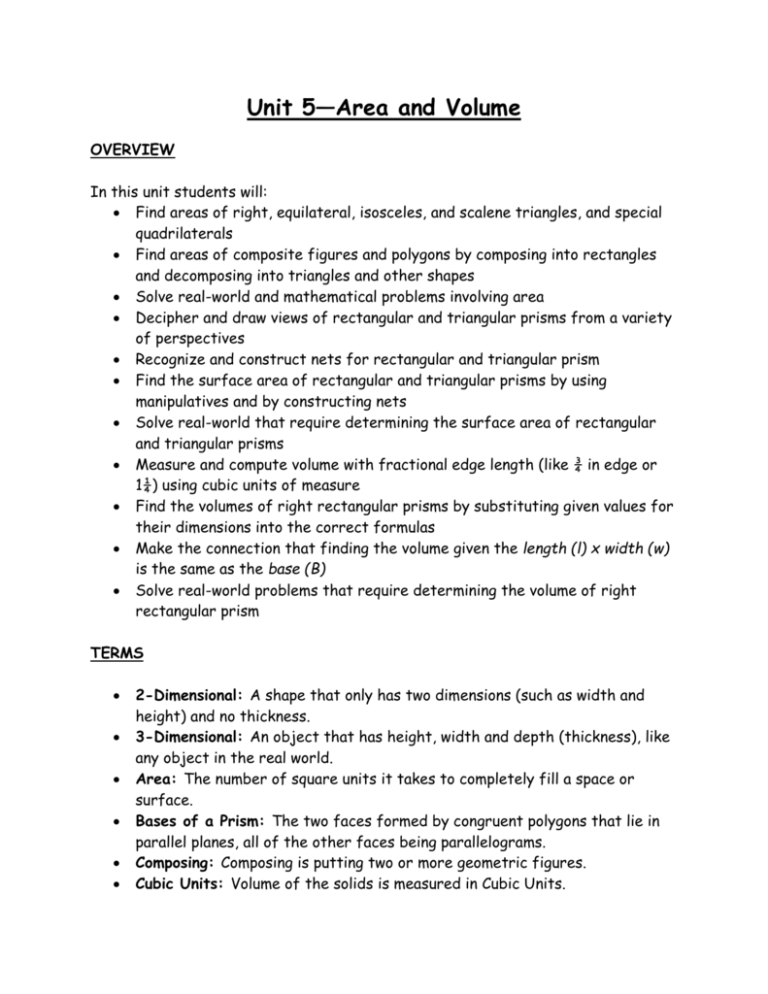
Unit 5—Area and Volume OVERVIEW In this unit students will: Find areas of right, equilateral, isosceles, and scalene triangles, and special quadrilaterals Find areas of composite figures and polygons by composing into rectangles and decomposing into triangles and other shapes Solve real-world and mathematical problems involving area Decipher and draw views of rectangular and triangular prisms from a variety of perspectives Recognize and construct nets for rectangular and triangular prism Find the surface area of rectangular and triangular prisms by using manipulatives and by constructing nets Solve real-world that require determining the surface area of rectangular and triangular prisms Measure and compute volume with fractional edge length (like ¾ in edge or 1¼) using cubic units of measure Find the volumes of right rectangular prisms by substituting given values for their dimensions into the correct formulas Make the connection that finding the volume given the length (l) x width (w) is the same as the base (B) Solve real-world problems that require determining the volume of right rectangular prism TERMS 2-Dimensional: A shape that only has two dimensions (such as width and height) and no thickness. 3-Dimensional: An object that has height, width and depth (thickness), like any object in the real world. Area: The number of square units it takes to completely fill a space or surface. Bases of a Prism: The two faces formed by congruent polygons that lie in parallel planes, all of the other faces being parallelograms. Composing: Composing is putting two or more geometric figures. Cubic Units: Volume of the solids is measured in Cubic Units. Dimension: a measure of spatial length; a linear measurement Decomposing: subdividing a polygon Edge: The intersection of a pair of faces in a three-dimensional figure. Equilateral Triangle: A triangle which has all three of its sides equal in length. Face: One of the polygons that makes up a polyhedron. Fractional edge length: The length of each edge of the cube is a fraction. Isosceles Triangle: A triangle which has two of its sides equal in length. Kite: A quadrilateral with two distinct pairs of equal adjacent sides. A kiteshaped figure. Lateral Faces: In a prism, a face that is not a base of the figure. Net: A two-dimensional figure that, when folded, forms the surfaces of a three-dimensional object. Parallelogram: A quadrilateral with both pairs of opposite sides parallel. Polygon: A number of coplanar line segments, each connected end to end to form a closed shape. A regular polygon has all sides equal and all interior angles equal. An irregular polygon sides are not all the same length nor does the interior angles have the same measure Polyhedron: A 3-dimensional figure that has polygons as faces. Prism: A polyhedron with two parallel and congruent faces, called bases, and all other faces that are parallelograms. Quadrilaterals: Four coplanar line segments linked end to end to create a closed figure. A 4-sided polygon. Rectangle: A 4-sided polygon where all interior angles are 90°. Rectangular prism: A solid (3-dimensional) object which has six faces that are rectangles. Rhombus: A quadrilateral with all four sides equal in length. Right Triangle: A triangle where one of its interior angles is a right angle (90 degrees). Right rectangular prism: In a right prism, the lateral faces are each perpendicular to the bases. Scalene Triangle: A triangle where all three sides are different in length. Square: A quadrilateral that has four right angles and four equal sides. Surface area: The total area of the 2-dimensional surfaces that make up a 3-dimensional object. Trapezoid: A quadrilateral which has at least one pair of parallel sides. Triangles: A closed figure consisting of three line segments linked end-toend. A 3-sided polygon Triangular prism: A prism whose bases are triangles. A solid (3-dimensional object what has five faces: three rectangles and two bases. Vertices: The common endpoint of two or more rays or line segments Volume: The amount of space occupied by an object. Volume of a Prism: The area of a base times the height. The number of cubic units to fill a prism.


